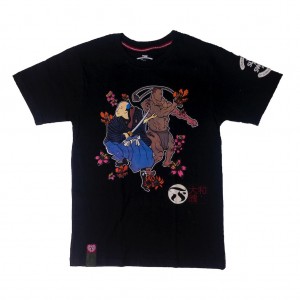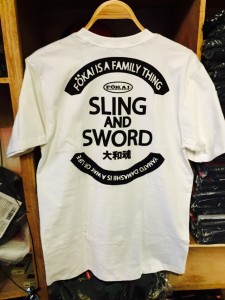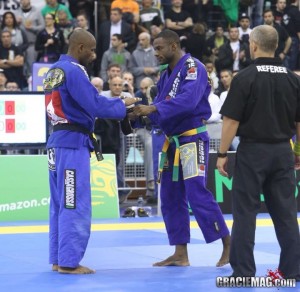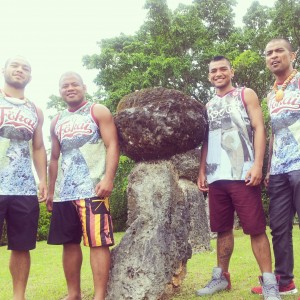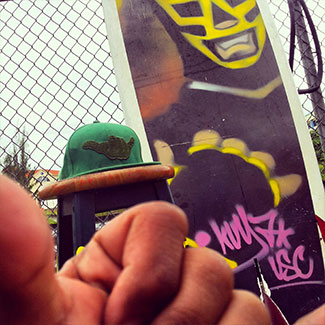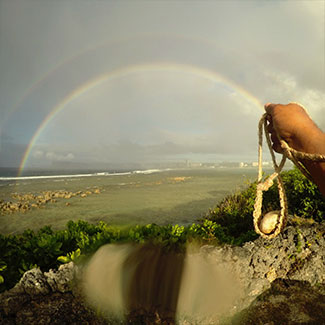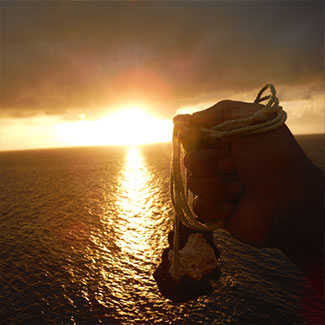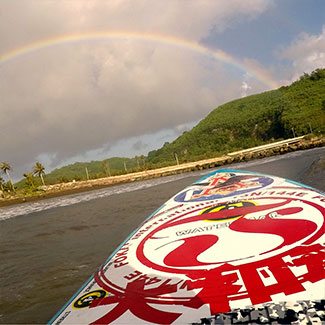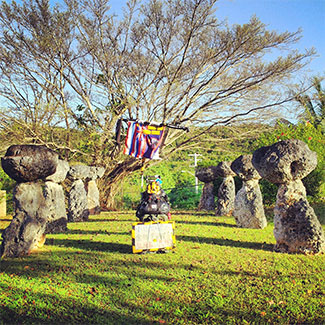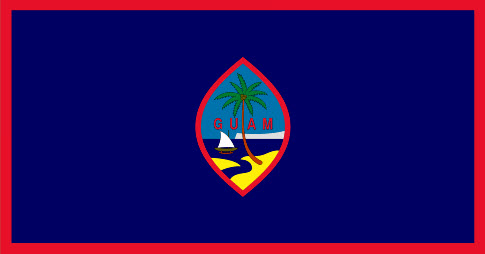TheForce?
Use the Force!
This phrase has been popularized all over the world by Star Wars but the concept of the force is nothing new.
All throughout history, people have come across certain things like ki (or chi) in martial arts, and a concept of God in spirituality. It’s been depicted as something cosmic, something magical, and even something divine.
All of these things dictate unseen elements that make the impossible possible and places the seemingly unattainable into the palms of our hands.
After thinking of so many things that have defied reason and science–we cant argue the fact that there are somethings out there far beyond rational explanation.
This is something we’ve always believed in and leaned towards. Weve made so many mistakes in our growth as a movement, a company, a family, and a clothing label; for whatever reason–were still around. Sinceeversince, we’ve always felt some extra help. For whatever we couldnt come up with up front, we searched for within, and if still we couldn’t find it–we’d pray for from above. And the Lord, whoever that might be keeps coming.
Inside and outside of FokaiIndustries, we’ve all been put here for a grand purpose. We are fortunate to find that through our line of of work and we can’t deny the calling for us to serve.
As human beings we are mortal, as mortals we’ve almost felt that our limits as men put things far beyond us. And in many cases, most of us have given up. For most, this seems true but where there’s a will, there’s a way.
Its this will, this “force” that advances us as a people.When things get tough we pray to a higher power and quite often in mysterious ways , something a “force” comes to answer our prayers. Even when our eyes are open this thing hiding up front seems easy to identify but it’s still something difficult to organize properly into words. Like the air we breathe, even though invisible it proceeds to give us life.
In a world outside of Hollywood theatrics,It’s a whole lot more than moving things with your mind. Understanding this and trying to come to the best of terms with fully is a lifetime pursuit and challenge, but its definitely worth the effort.
For the good of man and as strength for the weak– its a pursuit we believe in and are happy to standby.
In everything you do– for better not for worse,May the Force be with you.e
PS. Don’t give in to the Darkside!
TEAMWORK: Nova Uniao
After ging undefeated, Jose Aldo, former UFC 145lb. Champion, took his first loss against a fight more than a year in the making agains”TheNotorious” Conor McGregor.
Critcs, fans, and keyboard warriors from around the world have chimed in ridiculing Aldo for his 13 second loss and his chances for an immediate rematch.
In the heat of the MMA moment, as fans, we get consumed in the excitement and often forget the struggles that accomplished fighter-athletes have made on their climb to the stop or even to the bottom of the pool.
Here is an open letter to the public from Aldo’s longtime coach and more following Aldo’s very disappointing loss against the new UFC 145lb. Champion.
I have a deep sense of loss at this moment. Not only because of Jose Aldo’s belt, but mainly because of the lack of respect to our great champion, who maintained the UFC belt for four years and seven months, for seven fights (not counting his almost two years and three fights with the WEC title). I got back (to Brazil) and saw comments from people that certainly don’t know anything about fighting. And if they do, they never got anywhere, because those who achieved something in our sport know how hard is to compete at the highest level, against athletes from all over the world, and defeat them for many years.
When Brazil had no other champion, in a tense moment, Aldo maintained his title. After that, two other Brazilians joined him, maintaining the fame and recognition of the country in MMA. The only thing I ask everyone is respect to our great champion. For those who say it was fixed, I’d rather not comment, because they don’t deserve time and attention.
Last Saturday, Jose Aldo lost his belt in a fight in which he couldn’t show how well trained and prepared psychologically he was. There was no taunting that could enter his head, there was no technical failure, just an unusual blow. A blow like that, connecting in someone’s chin while moving forward, isn’t something that happens all the time. But it has happened with us. If it was the opposite, with McGregor being punched in the chin and Aldo in the eyebrow, we would be calling Aldo a superchampion today, the best of all times, but this is how sports are. Better luck for McGregor, who won and, therefore, is the new champion.
We need to understand that Jose Aldo is a human being subject to defeats, like any other. Those who show up criticizing him should think: this guy came from Manaus to Rio with nothing, to live in a gym, sleep on the mat, and wake up late so he wouldn’t starve since he had no money to have breakfast. He got where he were, always believing he would be a champion, and became one, due to hard work and dedication. The people’s champion.
Would those who are out there criticizing, talking about embarrassment, have the courage to do what he did? I bet not. If they did, they would know how hard is to win in a country where it’s rare to have support to sports. My message to critics is this: get up from the chair, get out from the computer, drop the phone, and do better. We need more people like Aldo and less critics from the couch.
The king has left, but will be back shortly.
Andre Pederneiras, Nova Uniao leader. More than a team, a family
Onra:PXC1
Hafa Adai,
Heres a write up for Pacific Xtreme Combat 1 to highlight their 50th headline event in Guam for December 4th. Respect for everyones opinion on this but we remember things a little differently.
Thank you to all the Supporters and Sponsors of Jungle Rules, Fury FC, and Fury FI..
In the world industry of professional fighting though only a few people get the official title but heres the truth…There are many ways to be promoters of Mixed Martial Arts.Thanks for all you have done, are doing, and aspire to do for martial arts and its positive contributions to and for our people.
Sinceeversince…TEAMWORK!
Thanks for Dropping by.
frm www.guampdn.com
by Grant Wieman
Pacific Xtreme Combat will hit a new milestone this weekend when the local promotion records its golden anniversary. PXC 50 will feature a handful of off-island fighters, two title bouts and a number of promising young fighters who can realistically dream of some day reaching the highest level of mixed martial art, the UFC.
The journey from the first professional full-contact fights in Guam to now has seen several promotions pop in, pop up and fade, but the PXC has continued to thrive. Unorganized street fights and backyard grappling sessions kicked things off more than 20 years ago.
John Calvo, MMA pioneer: It was just like a private club. We had our little jiujitsu club with Dan O’Connor as our head instructor. That was going on for maybe two years or three years until Dan had gone off to pilot school. Then my man Melchor (Manibusan) came back from Australia. There really wasn’t much of a scene. We just trained back yards.
Roman Dela Cruz, Fury founder: In the earliest days of training, while the most of us were still focused on learning what was a shockingly new and effective form of self-defense, John Calvo, who always thought into a much bigger box, had the vision of our group of training partners hosting an event.
Joey Calvo, PXC president and co-founder: I was living in California and actually watched the first UFC and was looking around for different jiujitsu gyms. … Ralph Gracie opened a gym in Mountain View that was like 10 minutes away. I trained there for a year and I moved to Guam in 1995. It was just garage training. You would fight anyone, these garage guys. I was playing in the Miller Football League at the time, too. We would invite these big football players back to the garage and pull out the mats and practice jiujitsu against these big football players. Jiu-jitsu would always win out. One or two minutes is all it takes.
Eli Monge, PXC vice president and co-founder: There was so much local talent on Guam.
Stephen Roberto, PXC 1 fighter: The first fight was SuperBrawl.
T. Jay Thompson, SuperBrawl promoter: I started in 1995 in a little bar (Gussie L’amour’s) in Honolulu completely sort of by mistake. The bar owner and I had both seen this crazy stuff on TV (UFC Superfight). … Eventually I found a promoter who had wanted to do a bigger show at the Blasedale Arena. I did three in 1996 and one in 1997. There was obviously a lot of news stories and politicians talking about it.
For a short time, the perceived violence led to controversy. Thompson had the fighters wear gloves, a decision he regrets, but the sport was eventually banned in Hawaii. He was looking to continue holding SuperBrawl promotions, but he needed a new venue.
TT: I had a friend named Chris Fernandez who had just started managing in Guam. I said, how do you think this would do if I brought it over there?
Joey Calvo: T. Jay showed up at the station and asked to meet the manager. He just wanted to buy advertising at first and he wanted to get sports coverage and video production. The video production back then was nowhere near the video production that goes into an event now. It was just a walk up at first. He wanted to buy advertising.
TT: I set up an office at the back bar of G-Spot and fighters came in and auditioned. They talked about being good street fighters, years of doing karate or taekwondo. It really was you could make up whatever you wanted and if it sounded good, you’d be thrown in.
John Calvo: The promoters were looking for guys on Guam. They had heard about people in the wrestling community and they reached out to me and Melchor. That’s pretty much it. Me and Melchor both signed up. Melchor pulled out because he was afraid he wouldn’t get a chance to go to the Olympics.
SuperBrawl 5, the first on Guam, was held on Aug. 23, 1997 at the University of Guam field house. Fights were held in a 24-foot boxing ring with minimal rules — no biting, no eye gouging and no groin strikes. There were two four-man tournaments, one for heavyweights and one for lightweights, and a main event that featured Dan Severn, the reigning Ultimate Fighting Championship winner and one of the most famous MMA fighters in the world with more than 100 career MMA bouts. Severn returned to Guam twice more, for SuperBrawl 7, held in 1998, and PXC 1.
Dan Severn, SuperBrawl 5 champion: I competed in just about every organization at one time or another. The phenomenon of cage fighting caught on like wild fire. It was like the wild, wild west. Back in the day there was no time limit, no weight classes, no rules. It was absolutely crazy.
John Calvo: Back in the SuperBrawl days it was actually pretty raw. They didn’t have a boxing commission or a fighting commission. They didn’t even know how to judge it.
T. Jay Thompson, SuperBrawl promoter: The no-holds barred fighting community was very small back then and we all knew each other. Dan ended up fighting for me 10 times probably.
DS: Guam was beautiful, rustic. It was like a step back in time. The cool part was I met a couple military personnel. They took me on base, took me snorkeling. It was a beautiful experience. … I just took a lot of long walks around different areas. I’d just be out on the beach. People would be out there playing beach volleyball, they see me; I’d jump in.
TT: It was a really easy transition from Hawaii because the fighting culture was so similar. I do remember hiring a local security firm at the field house and looking around the arena and seeing a lot more people than we sold tickets for. The talent immediately was, I wouldn’t call it high-level, because it was so brand new, but the fighting spirit was there, much like in Hawaii.
John Calvo: I won the heavyweight tournament and fought Dan Severn the next round.
TT: I was looking for a draw in 1998. I picked Big John Calvo, with two fights, to fight Dan Severn. (Calvo) is probably the original fighting pioneer for MMA in Guam that I can think of.
John Calvo: It was overwhelming, but I was convinced, “He’s a human being. Nobody is bulletproof.” That was my attitude. … It was weird because at that time the stereotypical tough guy wasn’t a guy with glasses. I was a surfer guy. It was weird for me but it was fun to get a lot of respect.
DS: I didn’t know much about him. I heard he was the island bully from a very influential family. They were young rogues, males of the family. He was one of the biggest bullies on the island and it was the perfect match we set up with this guy and I think a lot of people were happy with that I put him in his place. Or, maybe a better way to put it is, I served him up a nice piece of humble pie.
John Calvo: I didn’t know much jiujitsu. I didn’t know much of anything. I don’t know if it was ignorance or heart. It was a fun experience.
Five SuperBrawls were held on Guam, concluding in October 2000. By then, Thompson had successfully found a loophole in the Hawaiian laws that allowed him to promote more fights in his home and a new figure had stepped up to hold fights on Guam. Roman Dela Cruz, founder of Fokai Industries, began holding Jungle Rules in August 2001, but the business opportunity quickly drew in other challengers. A group from KUAM and Tropical Productions stepped into the fold in 2003. Dela Cruz’s Jungle Rules evolved into Fury Full Contact Fighting, sponsored by Budweiser.
Roman Dela Cruz, Fury founder: After hosting a few submission grappling events and feeling the faith and support of the community, we felt the local movement for local fighter athlete development was served best by the hands of the people effected most directly by it. After a long talk with Enson Inoue and TBoogie Anderson, after a heavy day of training at Purebred Shooto Gym Guam, we decided that the dream was worth the effort and got the wheels turning to make it happen.
Stephen Roberto, PXC 1 fighter: Roman Dela Cruz, John Calvo and Tony Anderson teamed up together to form Jungle Rules.
RDC: Although there might be a few names widely recognized for Jungle Rules, it needs to be said that the event was a product of the combined effort; a large group of close friends that had high hopes for Guam fighters, including the fighters themselves.
TT: I really enjoyed promoting in Guam and I love the culture and the people. I completely enjoyed the amount of time I stayed there.
RDC: Fury was created largely because there were no events in Guam. Jungle Rules 1 and 2 were executed properly enough that the prior promoter figured that he’s better off staying busy in other places. He saw that local promoters had filled that gap. And without all the moving parts for Jungle Rules 3 in line, Fury was born.
TT: They were businessmen, so it wasn’t going to take long. They weren’t going to let some haole businessman jump from Boston to Guam. Somebody locally wanted to do their own show and I didn’t want to fight it. I had so much going on, bigger shows (in Hawaii). I probably wouldn’t have stopped going, but I’m not bitter about it.
Eli Monge, PXC vice president and co-founder: When Joey (Calvo) and I started PXC, we were just in love with doing martial arts. We wanted to set a stage to showcase some of the local talent. There was so much talent on Guam.
Joey Calvo: Eli and I were both into jiujitsu. We knew all the local guys. We trained with them. In three or four months, we put it together. It wasn’t really a lot of had work. We were doing it already and then our sister company, Tropical Production, they were doing concerts so we had all the resources for sound and lights.
EM: I had an office at KUAM. (Joey) walked in and he was just fed up with the outside promotions paying so little to the locals and that’s where it started at.
Joey Calvo: The way my family does business is a lot of collaboration. There was a little skepticism about getting into the fight game. My dad wasn’t really sure about it — there was a lot of risk and liability — but he gave the approval.
RDC: The world of competitive fighting was in thick transition from the question of art versus art to athlete versus athlete, from no holds-barred to mixed martial arts.
EM: I remember all of us sitting down and Joey telling them we were going to be doing a new promotion. Everybody starting pitching their ideas of the name. We came up with some crazy names.
Joey Calvo: Like a lot of things in my family, we do it at family dinners and brunches. It’s a collaboration of a bunch of guys in the family. We had some crazy names involving war and volcano eruptions. We wanted to mimic the UFC, the NFL, and something to brand the Pacific region.
EM: We were having lunch with all the brothers and we wanted to have Guam or Pacific in the name and that’s when we came up with Pacific X-treme Combat. A few of the brothers would say they came up with it, but it was a joint effort. I wanted some crazy stateside name.
Joey Calvo: Big John was with us back then and he came up with mocks of logos and we unanimously agreed on that, with the big red X. … We’re still using the P and the red X and the C. We’ve fine-tuned it a little bit.
SR: You’ve got the Budweiser camp and the Miller camp, and they were using the events as a way to market their products. Mixed martial arts was the hot item and they were looking to get into it.
John Calvo: Me and Roman, we stopped being partners. He went his own way to do (Fury). That’s when it became a business. It became competitive.
Joey Calvo: (Eli and I) trained with Roman a little bit. He was part of that Purebred gym in Hagåtña. We did the first (Jungle Rules). The first one was sponsored by KUAM, Tropical Productions and Miller. They went to Shimbros and Ambros after that. Roman approached us to sponsor Fury also, but we were already talking about doing PXC at that time. And then came the war of the dates.
Fury Full Contact Fighting 1, headlined by a fight between Enson Inoue and Soichi Nishida, was held Jan. 10, 2004 at the UOG Field House inside a custom-built cage. A week later, on Jan. 17, Brazilian jiujitsu student Stephen Roberto and police officer Manny Chong battled in the local main event of Pacific X-Treme Combat 1, also at UOG. Both drew a sellout crowd. Those fights were in a converted pro wrestling ring.
Joey Calvo: We set our date first and we heard a few weeks after that that they set their date. There was a little bit about, “Well, what a bunch of jerks,” but it was mostly, “Lets make sure when we throw our event, our event is better. Lets make sure the fans have a good show.” You can’t fool the fans.
RDC: The goal (of Fury) was and still is (1) to cultivate and steer MMAs positive position, path and effort for the people of the Mariana islands, (2) to provide our athletes with a quality platform in competition, (3) to showcase our islands and its people honorably to the world.
EM: We wanted just an outlet for these athletes. We wanted to create an ambiance where these guys could showcase their martial arts and their training, their fighting, a proving ground. And we accomplished that.
SR: Manny Chong and I were supposed to be the main event at Fury 1. The PXC promoters convinced Manny not to fight in Fury. I had already been training for three and a half months at that point and I was not going to let my opponent run away from me, so I ended up following him to PXC. … It was within weeks of the event. When you’re training that hard, I didn’t (care) where he was. I want to fight this guy.
Joey Calvo: We thought we did a better job marketing and promoting the event than the other guys. Not to say that that other guys weren’t successful, but we were just really over the top.
SR: PXC always focuses on the production of things and Fury was focused on the fight itself. I remember walking down, they built like, this ramp so they took out a whole section of seating to build this ramp. It was very much Pride; a lot of pyrotechnics, smoke, lights. Fury wasn’t about that.
John Calvo: PXC seemed to be putting on a more polished product. It was marketed as the premier mixed martial arts event. Right out the gate you could see the production value was on a different level.
SR: PXC tends to put a lot of backstory behind the fighters to make it seem like there’s some kind of grudge. And they really like fighters to have a nickname. I didn’t want a nickname. My name is Stephen Roberto, that’s what my mom named me when I was born. So they billed me. I was Steve “The Hitman” Roberto and it was Manny “The Enforcer” Chong. I was supposed to “take out” the cop. Fury was all about the fight. Steve Roberto, decorated jiujitsu athlete. Chong, street brawler. He was using his street skills to get himself in the (cage). It was more about your skill sets rather than our personalities. PXC always focused on the production of things and Fury was focused on the fight itself.
Joey Calvo: That just shows how hungry the fans of MMA were. With back-to-back dates, they were both pretty successful.
John Calvo: Even though it was the same venue, it felt like a whole different vibe. They had the Miller Girls. It was a lot of hoopla. The line stretched to the end of the road. It was a lot of fun.
SR: I remember walking into the field house a couple hours prior to show time and the line was ridiculous. It was jam-packed; a lot of hype, a lot of build-up prior to the fight.
Joey Calvo: It’s a lot better now, but back then it was a very challenging venue to throw an event. The concessions, the bathrooms, it’s not laid out to have an event like that. It’s hard to secure. There are many access points for people to walk in.
SR: Eli Monge tells me all the time, that was the biggest gate, the biggest attendance, of any mixed martial arts show to date. It was so frickin’ hot by the time I came out to fight in the main event I had a hard time breathing in the field house. It seemed like all the oxygen had been consumed.
EM: The first night where I sat down and looked at Joey and said, Man, this is incredible. It was wall to wall, there were people standing. We looked at each other and said, Man, this is awesome.
Roberto lost his fight to Chong — “I had a lot of people come up to me afterwards, telling me they lost money betting on me. I told them that’s their fault for being stupid and gambling” — but got his revenge at Fury 3. The PXC 1 card also included two off-island bouts. Hawaii’s Justin Mercado beat Californian Josh Smith by decision and Dan Severn beat another fighter from California, Ray Seraile. PXC’s formula of bringing in high-profile off-island fighters and matching them up with guys on Guam helped separate them from the earlier promotions, and eventually turn the PXC into a proving ground for young fighters, paving their way to the UFC.
Joey Calvo: The first goal was not to lose money. The second goal was to promote the sport and develop local fighters and see how they can go and improve their skills and how they would compete against off-island guys.
John Calvo: PXC was bringing guys in from all over the country. … It wasn’t hard finding fighters. People were reaching out to me. I was a fighter also. People wanted to fight on Guam and the only guy on Guam they knew was me. We were turning guys down.
Joey Calvo: The MMA world, it’s really small. It’s really not that hard to get in touch with guys. The hard part is to weed through the real guys from the pretenders.
DS: Promoters see I’m independent. … I basically traveled by myself. (For a coach) I’d just look around the room and go, hey, what are you doing for the next 15 minutes? I didn’t need a corner person. I put together my own game plans. I just needed someone to hand me a bottle of water and a towel between rounds.
John Calvo: We focused on just making sure the fighters were treated well. It was a lot of fun at the time. It was hard work. The guys would come in, we’d watch a lot of good fights that weekend, then we’d barbecue and break bread.
Joey Calvo: That was the tough thing, too, seeing a guy who wasn’t ready yet fighting an off-island guy. The Guam guys have a certain amount of pride. They want to fight an off-island guy. My favorite fighters are the guys willing to fight anybody.
John Calvo: PXC per capita has had more fighters go on to fight in the big show, the UFC, than a lot of other smaller events and I think that’s because of the stuff we did in the early days.
EM: It’s good to see the UFC fighters that came from PXC, and that was always our dream. … We have guys that just fricking fought for us and made it to the bigger stage and that is my gratification. Because we’re a small company, we’re never going to be as big as UFC.
Joey Calvo: We want to develop guys and see how far they can go. What’s really even felt better was when we got our first local guys into UFC. When you get your first guys from Guam in there, that’s when you really feel like you had a positive impact on somebody’s life.
Fury held seven events, concluding in Dec. 2006. PXC debuted its cage, the Terror Dome, at an event earlier that year. There were ups and downs — brawls outside the ring, power outages at the field house during the show — but the organization kept expanding. It has since held fights in Saipan, the Philippines and even Miami. More than a dozen fighters have made the jump from PXC to UFC, including Jon Tuck and Jon Delos Reyes from Guam. Two women’s fighters, Kailin Curran and Cortney Casey, have passed through PXC on their way to UFC.
RDC: With another event doing a great job, the job of having local guys promote local shows was already taken care of. We didn’t care to see people get consumed with the dividing lines. There were so many other gaps in our lives, as well as gaps in responsible martial arts cultivation to fill elsewhere, so we decided to be like water and fill those gaps. And we’re still doing so today.
Joey Calvo: We kind of anticipated they would always come back at some point. I don’t think they ever made an announcement they were going to step down. There was never that thing where, oh man, we beat them, they’re done. We just kind of do what we do and not worry about what other promotions are going to do.
RDC: Though we no longer hold these full-scale events, Fury never truly stopped. Fury is a name given to the event and the event was a vehicle that covered the bases of our three goals. I try to do my part in Fokai Industries to see that we continue to do the same. My partner Steven Shimizu moves forward with Fury Promotions and still continues to do so this day with almost ten years growing the Marianas Open and Copa de Marianas (BJJ tournaments).
Joey Calvo: We didn’t think it was going to be this big, huge business success. We weren’t planning out really long-term, it was just fight-to-fight, seeing how it went. We felt really felt good after the first fight and after that, the crowds were all the same. We were getting the same kind of attendance for every fight and after one year it was like, man, we’re really got to start devoting some work into this.
SR: I’m not surprised that they’ve been able to have some staying power. They put some good people behind it. They put some good resources behind it. It’s a no brainer. They got into it at the right time and they’ve been giving people good fights.
John Calvo: I think back. It was just so different. Today they really got it going. It’s so much more professional than it was back then.
TT: I like that they continued the tradition. Watching PXC in the Philippines, all this stuff, it’s fantastic.
EM: There’s a lot of fighters that really helped us to get to where we are at right not, and that’s not including the fans. We wouldn’t be where we are if it weren’t for them.
RDC: Even with whatever success and highlights we might have enjoyed — in Jungle Rules, Fury Full Contact Fighting and Fury Fighting Islands — the thing that has kept, is keeping, and will forever keep these events, fighters and accolades going are the people of Guam.
Para I Onra: The Ana Varu
During a trip visiting Ireland in 2010, I was with Tony Susuico(another Guam native) enjoying the view from a cliffside overlooking the famed Cliffs of Moher. There we met an old Shepherd (who at one time was a sailor) who was also walking the Cliffs and, in the midst of a hello and good conversation had given him a Fokai Sticker with the coordinates 13 North /144East..He read the sticker and quickly narrowed down the location first to Micronesia and then soon the Mariana Islands.
From there he connected the Mariana Islands with the Flying Proa and told us of its legendary status among seafaring men from all parts of the world.. This was the oddest and most random thing. Although we were surprised that he was able to narrow down the location as well as his familiarity with the Flying Proa It wasnt until years later, reflecting on this experience that its gravity had really set.
Its pretty amazing how a population so small and from a place so isolated that seafaring men n the other side of the world would know of our people through excellence as engineers and our proficiency as sailors. .
And its just as sad that despite this great accolade, its a craft and artform that our people f today are s separated from, that teh vast majority cant even recognize the mistake thats inside of the flag that we fly so proudly today.
t
Local seafarer prepares for Taiwan-Guam voyage
Local seafarer Ignacio Camacho recently returned to island from close to four months of training with a Chamorro proa in the Baltic Sea in preparation of a weekslong voyage from Taiwan to Guam.
Next year, Camacho will be taking part in the Rapa Nui Experiment, a voyage orchestrated by German adventurer Burghard Pieske.
Pieske plans to sail a traditional Chamorro-style proa from Taiwan to Easter Island, traveling with seafarers from the various Pacific islands across the ocean.
The voyage takes its name from the indigenous name of Easter Island, also called Rapa Nui.
Camacho will accompany Pieske on the first and longest leg of the trip between Taiwan and Guam.
The proa, which is named the ‘Ana-Varu, measures about 11 meters long, roughly 36 feet, and is modeled after the Chamorro-style proa.
The ‘Ana-Varu takes its name from a legendary Tahitian pillar of heaven and is also the Tahitian name for one of the three stars located in Orion’s belt.
Those stars also held significance for the original navigators in the Pacific, having different names across the various island nations.
The original Chamorro name is now unknown, Camacho said, but local navigators refer to them as “the three stars” or “the stars that are three.”
The stars’ importance will also carry over to this adventure.
“The interesting thing is I’ll be sailing ‘Ana-Varu in the direction of ‘Ana-Varu, the star, from Taiwan to Guam,” he said.
The proa takes other design elements from other Pacific nations.
At one end stands a miniature moai, the famous monolithic statues from Easter Island.
Camacho said the use of design elements from across the Pacific is symbolic of the trip itself.
“All of the peoples of the Pacific are related to each other in their voyages and in some of their origins,” said Camacho.
“And we all have different symbols and traditions but they all really add up to one thing: one Pacific peoples with a common past, a common history and a common culture.”
That idea gets to the whole point of the voyage.
“Burghard wants to not only show how the migration happened, but the fact that the outriggers of the many different types of people were what populated these islands and that these were absolutely beautiful craft even thousands of years ago,” he said.
Pieske also wants the voyage to “instill this sense of pride” in the people of the Pacific, he added.
Boat design
Although it takes its structural design from the Chamorro design, the ‘Ana-Varu has the advantage of modern materials, said Camacho.
The biggest difference, he said, is that the ‘Ana-Varu is designed to be sailed by two people, whereas traditional proas originally could require larger crews to maneuver and sail.
The most obvious difference is how the mast is adjusted.
Unlike western sailboats, a change in direction in a proa requires sailors to pick up the mast and move it to the opposite end of the vessel, a move referred to as shunting.
In a standard proa, Camacho said, this would require a team of sailors and a lot of rope.
Camacho and Pieske, however, took advantage of winches, pulleys and blocks that allow them to move the mast and adjust the sail.
He noted that it could also be sailed by a one-man crew if necessary.
Camacho recently spent four months in the Baltic Sea, north of Germany, practicing with the vessel.
That sea is renowned for its less-than-ideal sailing conditions, which is why they chose it for sea trials.
“It had large swells, some of the meanest waters in that small area that you can imagine,” he said.
Camacho said his experience sailing proas has involved lots of open “blue water” sailing outside the reef.
Having that experience with the Pacific’s wind and wave patterns coupled with the challenges he experienced in the Baltic, “is gonna make it seem quite easier” to make the trip next year, he said.
The voyage
The goal, Camacho said, is to officially launch the voyage in February, when sailing conditions will be ideal.
They’re estimating the trip to take any where from 21 to 36 days.
“Twenty-one days sounded like a good thing,” he said. “That’s three weeks on the open ocean. It sounded relatively comfortable.”
“We talk about three months on the open ocean? That might be a different story,” he added. “But that might happen; it’s possible.”
Pieske’s entire voyage to Easter Island could take up to three years. That would include stopovers of various lengths at Pieske’s Pacific waypoints.
Although Camacho is only committed to the first leg, he said he’ll be “on standby” in case Pieske needs another crew member during the trip.
Given that it’s the longest stretch of the voyage over open ocean, Camacho said, they have made sure to be “over-provisioned” for the trip.
During the voyage, Camacho said Pieske will be journaling as well as taking video and photographs of the trip.
If possible, he added, they hope to be able to provide real-time updates to those following the voyage.
Although they will likely have a GPS tracking beacon on board for safety reasons, Camacho said he’ll be using traditional navigational techniques to guide their way across the water.
“I’ll have nothing to do with modern tracking or modern navigation,” he said.
Camacho said he’s studying and learning navigation every day leading up to the trip.
That involves learning patterns of stars and tides to identify where they are and where they’re headed.
Raising awareness
The pair plans to arrive in Guam in time for the 2016 Festival of the Pacific Arts. Once here, the ‘Ana Varu will stay temporarily before Pieske continues the voyage.
Ultimately, Camacho said, he hopes the voyage raises awareness of Chamorro seafaring traditions not only worldwide, but also here in Guam.
Camacho called on residents to take interest in local seafaring groups and learn about their efforts to revive the ancient traditions, noting the importance it has for the island’s history.
“We are a very special kind of people like no other,” he said.
Cultivate the Spirit: The Sling
What is the ” Sling” in ” Sling and Sword”? and what is fokai’s connection to it?
The sling is a weapon used across the planet from thusands of years ago. Its not certain who had been the first ones to do it; its theorized that it might be one of those things that just kind of showed up at the same time in unrelated places.
Besides joining David in the ongoing fight against Goliath, Our main connection to slinging is through culture.
The sling is an ancient weapon of the early native Chamorros and it was something very activated within the community. Considering that the ancient Chamorro society may have been around as long as 5000 years..it’s amazing that still hikers, bystandres, and archaeologists still find (are gifted) them today.
When the Spanish invaded Guam in 1521, what might have started out as gift-trading, evolved into a war when the Spanish decided to colonize a very peaceful and happy Guam. The aspirations to spread Christianity and give Spain more property and power, came at the cost of the lives of tens of thousands of Chamorros who didnt want to give up their way of life to surrender fightlessly to the greedy foreginers.
The Chamorro people had fought incessantly for close to 75 years. it was with the mobility of the Flying Proa that allowed the island rebels to retreat and regroup to outer islands to reset forces, and their proficiency with the sling to fight Spanish forces from a distance.
After Guam had lost the war, the majority of Flying Proas were destroyed and the art of slinging was banned . The rise of gun powder and moderne weaponry would prove the need for the sling to be obsolete, and outside of a few–the art of slinging has disappeared from the masses and has been for the most part tucked away in the decaying pile of many of Guam’s old traditions.
The revival of the art of slinging has been a great way to reconnect with the ancestors of Guam and holds a great sybolism for the active efforts to exhibiting out islands positively and formidably to the world.
Sling&Sword
The Sling is Guams native weapon, the sword is Japans native weapon. Sling and Sword is a collaborative campaign between fokai and yamato damashii to celebrate the bridge between Guam and Japan through martial arts and a statement of fokai’s connectivity with Yamato Damashii through martial arts principles and service to defend and protect the good side of the Force
Team Matao , Invigoration, &The Inifresi
via www.guampdn.com
Less than 24 hours before their match against the top-ranked team in Asia, the Guam men’s national soccer team is focused and confident.
After touching down in Tehran, Iran on Tuesday, Team Matao met with local media and acclimated themselves to the local conditions. During an interview with the Guam Football Association media officer, Matao head coach Gary White complimented the hosts, but said his team will come to compete Thursday night.
“The players don’t fear them,” White said. “They respect them, but they don’t fear them and we’re really looking forward to the game.
Guam challenges Iran in the second round of the 2018 FIFA World Cup Qualifier in Iran at 12:30 a.m. Friday, Guam time.
attached is also a video clip of Team Matao–Sounding the Inifresi before a match in international competition
MATAO:
Ginen i mås takhilo’ gi hinasso-ku
I mås takhalom gi kurason-hu,
Yan i mas figo’ na nina’siña-hu,
Hu ufresen maisa yu’
Para bai prutehi yan hu difende
I HINENGGE,
I KOTTURA,
I LENGGUÅHI,
I AIRE,
I HANOM yan I TANO’ CHAMORU
Ni’ irensiå-ku direchu ginen as Yu’os Tåta,
Este hu afitma gi hilo’ I Bipblia yan I Banderå-hu,
-I Banderan Guåhan.
…In English…
From the inner-most recesses of my mind,
From deep within my heart,
And with all my might,
This I offer.
To protect and defend
The Beliefs
The Culture
The Language
The Air
The Water and The Land of the CHamoru.
My heritage come directly from God,
This I affirm on the Bible and my Flag
– The Flag of Guahan.
Fokai,The Force, & Legends: Fernando “Terere” Agusto
August 29, 2015 by admin
Filed under BJJ Stuff, Familia, FokaiCombatUNit, FokaiIreland
Photo and story from Gracie Magazine
Alan “Finfou “Do Nascimento just brought the venue to tears. After conceding the win to Fernando Tererê in their middleweight match, he handed Fernando Tererê his black belt. He later explained his actions: Fernando Tererê made what I am in Jiu-Jitsu. He taught me since the white belt. This belt, he gave one day and asked for 5 reais and I knew it he was going to buy crack. I told him then that I was going to give him back the belt when when he got back on his feet. There’s no better moment than that! I will sleep filled with joy and proud today!”
Foundation: Rebuild Marianas
August 26, 2015 by admin
Filed under 1008, FokaiSaipan
By Katy Galimberti, AccuWeather.com Staff Writer
August 7, 2015; 10:00 AM ET
Once-Super Typhoon Soudelor pummeled the island of Saipan in the Western Pacific ocean on its path to Taiwan and China this week.
Soudelor slammed Saipan with the intensity of a Category 2 hurricane on Sunday night, local time. Winds were measured up to 105 mph as the storm hit. However, winds may have been stronger than those reports, AccuWeather Meteorologist Eric Leister said.
“Soudelor was going through a period of rapid intensification as it passed over Saipan so even stronger winds may have occurred,” he said
In Saipan, a U.S. commonwealth with a population of 53,000, fierce winds and drenching rain left a trail of damage…
Cultivate the spirit: The Wim Hof Method
Something to share for serious life enhancement and for the good of mankind. Wim Hof convincingly and selflessly reminds us that breath is truly the key to life
THE WIM HOF METHOD
Summary
- 30 times balloon blowing
- Breathe in fully
- Breath out fully and hold until gasp reflex
- Inhale fully and hold for 10-15 seconds.
- Repeat until finished
- Take 5 minutes to relax and scan your body
These are the basic steps in getting started wit the Wim Hof method, where Superhuman abilities are made possible through a comprehensive breath training curriculum with cold water training
Looking at victims and patients of cancer and other ailments, it seems that the medication for one makes you sick with another.
This is the unfolding story of a man and method that aims to teach us all that the cure is inside us
Over time, we, as humans have developed a different attitude towards nature around us and we actually forgot one thing, “inner power.” This is the relationship by our physiological mechanisms to adapt and survive within our natural environment, which is direct and effective.
Because we wear clothes and control the temperatures at home and work, we have changed the stimulation on our body, thus the old mechanisms related to survive and function. As these deeper physiological layers are not stimulated anymore we have become alienated from them, thus our bodies have weakened and we are no longer in touch with this inner power. The inner power is a force accumulated by full awakened physiological processes. It also influences the very core of our DNA
Wim Hof , Wim Hof Method
Results
- Boost Your Immune System To Bulletproof Yourself Against Sickness
- Become A “Super” Version Of Yourself In Just 10 Short, Life Transforming Weeks
- Learn Ancient Techniques In Combination With Modern Cutting Edge Strategies
To Increase Your Health And Wellbeing - Hack Your Body Using Cold Therapy To Feel Energized During The Day,
While Sleeping Like A Baby At Night”

